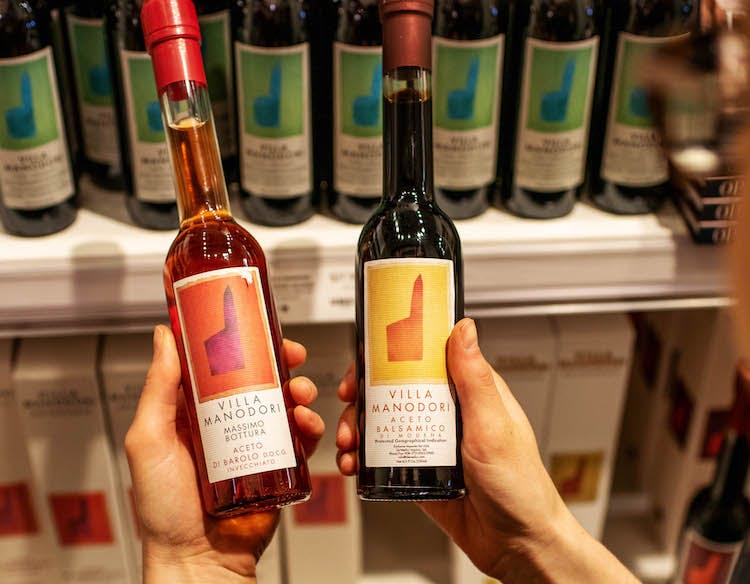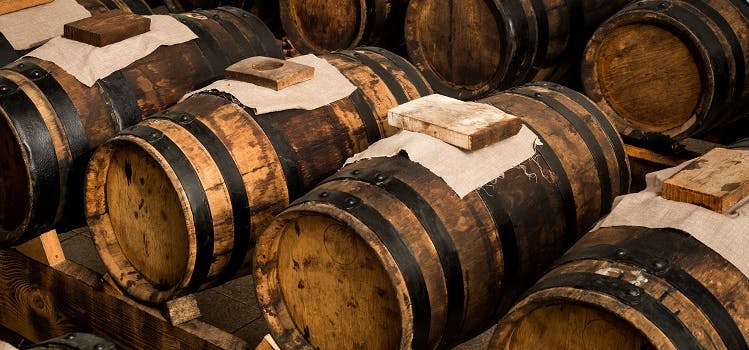We'll admit it – wandering through our balsamic vinegar shelves can be overwhelming! Eataly carries dozens of varieties of vinegar, each one coming from a different acetaia (vinegar producer), bearing a different label, and different bottle shape.
So, how do you know which one will suit your tastes? After speaking with our product experts, we've uncovered five things you should know when buying balsamic vinegar. Explore the guide below!

1. Know the different types.
First things first: not all balsamic vinegar is the same – and not all Italian vinegar is considered balsamic! There are two main types of vinegar that can be called "balsamic" under Italian law: Traditional Balsamic Vinegar DOP (Aceto Balsamico Tradizionale DOP) and Balsamic Vinegar of Modena IGP (Aceto Balsamico di Modena IGP). Traditional Balsamic Vinegar DOP is considered the ultimate Italian vinegar, is aged for 12 or more years, and has the most complex flavors. For this reason, it tends to be the most expensive. On the other hand, Balsamic Vinegar of Modena IGP is aged for less time and there is more room for variation in the ratio of ingredients used.
Then, there's everything else which cannot contain the word "balsamic," but instead is called condimento. This category includes sauces, glazes, and infused vinegar. Since condimento is not subject to Italian certification standards like balsamico, producers can get more creative with how they make their products.
2. Age matters.
Like a fine wine, the longer a balsamic vinegar is aged, the more deep and complex its flavors will be. Aged balsamic vinegar tends to have a denser, almost syrup-like consistency since much of the water has evaporated over the years, concentrating the flavors even more.
Traditional Balsamic Vinegar DOP must be aged for at least 12 years but can go even longer, with some aging for as long as 25 years. Balsamic Vinegar of Modena IGP is aged for 60 days and up to 3 years. Thus, checking the label for the aging period is a good indicator of how the vinegar will taste.
Note that Traditional Balsamic Vinegar DOP uses a color labeling system to indicate the age. Bottles made in Reggio Emilia use a red cap to correspond to 12 years, a silver cap to correspond to 15 to 25 years, and a gold cap to correspond to 20 to 25 years. Traditional Balsamic Vinegar made in Modena uses white to indicate 12 years and gold to indicate 25 years.

3. Consider how you will use it.
Some vinegars are better suited for cooking, while others should be reserved for finishing dishes at the end. Balsamic Vinegar of Modena IGP is perfect for cooking with because it can be reduced down into a thick sauce or used as a marinade. On the other hand, Traditional Balsamic Vinegar should never be heated, which will destroy its distinctive flavors. Instead, reserve this vinegar to finish special dishes. Drizzle it on fresh pasta, risotto, or grilled meats. It's also wonderful on top of creamy desserts like panna cotta, gelato, and zabaglione.
4. Observe the bottle shape.
If you're looking to buy Traditional Balsamic Vinegar, you'll want to check out the shape of the bottle to learn where the vinegar comes from. Traditional Balsamic Vinegar is produced in two main provinces: Modena and Reggio Emilia. Traditional Balsamic Vinegar of Modena comes in a spherical bottle with a rectangular base. The bottle is solid glass with a crystalline color. On the other hand, Traditional Balsamic Vinegar of Reggio Emilia comes in a longer shaped bottle.
Both Traditional Balsamic Vinegar from Modena and Reggio Emilia are of excellent quality and choosing between the two is really a matter of preference.

5. Check the order of the ingredients listed on the label.
Balsamic Vinegar of Modena IGP is made with two ingredients: cooked grape must and wine vinegar. The ingredient that is listed first on the label is more present than the ingredient that is listed second. What does this mean for flavor? Cooked grape must is sweeter and denser, while wine vinegar is more acidic and sour. So, if there is more cooked grape must in the balsamic vinegar, it will likely have a sweeter, more syrup-like taste, but if wine vinegar is listed on the ingredient list first, it will probably be a little more acidic.
This rule does not apply to Traditional Balsamic Vinegar which is made from 100% cooked grape must.